HOW TRUE BALANCING WORKS
Circuit Design and Theory of Operation
HOW TRUE BALANCING WORKS – FOR THE LAYMAN
True Balancing is an active balancing technology. That means it can move energy to any cell in the battery. Moving energy to cells at a low state of charge (SOC) can bring them into balance with cells at higher SOC. This balances the battery, which allows you to utilize the full capacity of the battery.
Voltage sensors are connected to each cell. The voltage readings indicate the relative SOC of each cell. This lets True Balancing know which cells need more energy to keep them in balance with the rest of the battery.
True Balancing uses a technology called switch mode dividers (SMDs) to move energy from cell to cell. SMDs are simple, low-cost, highly efficient circuits that are widely used. As an example, switch mode technology is at the heart of almost every consumer-grade power supply made today.
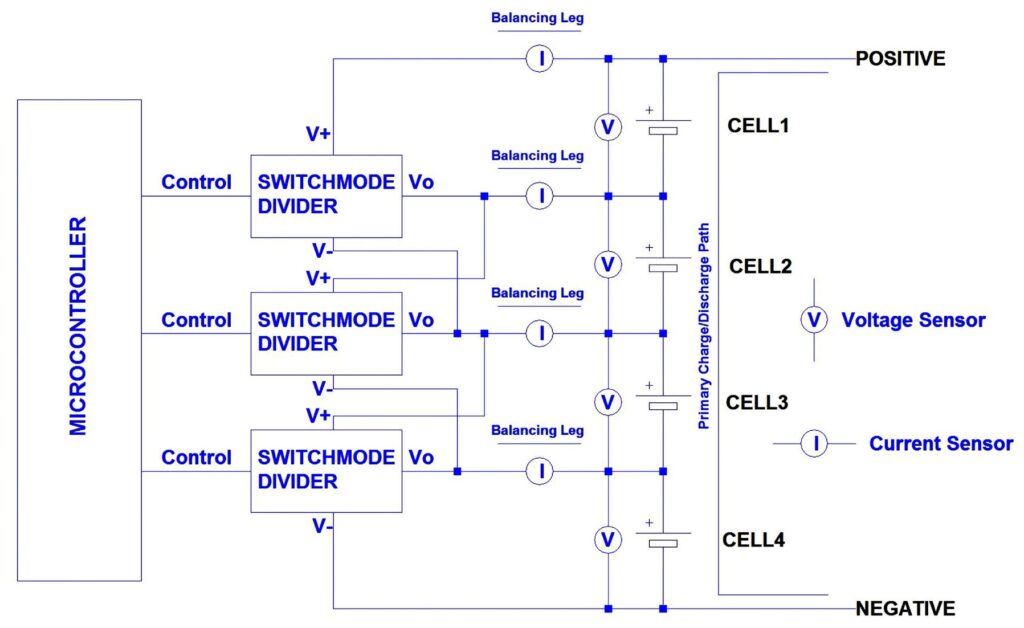
When True Balancing is balancing the battery, it moves energy from cell to cell on circuits that we call “balancing legs”. Each balancing leg has a small current sensor. The current sensors have two functions.
- Monitor the current on each balancing leg to make sure it doesn’t get too high. This allows safe, reliable operation of True Balancing.
- With measurements of voltage and current at each cell, we can calculate the internal impedance (or resistance) of each cell. This is a bit technical, but this is the feature that really unlocks the power of True Balancing.
If you know voltage and impedance on a cell by cell basis, and if you can selectively move energy to or from any cell in the battery, you have a level of control that is unprecedented in battery management. This enables the full range of benefits of True Balancing.
HOW TRUE BALANCING WORKS – FOR BATTERY NERDS
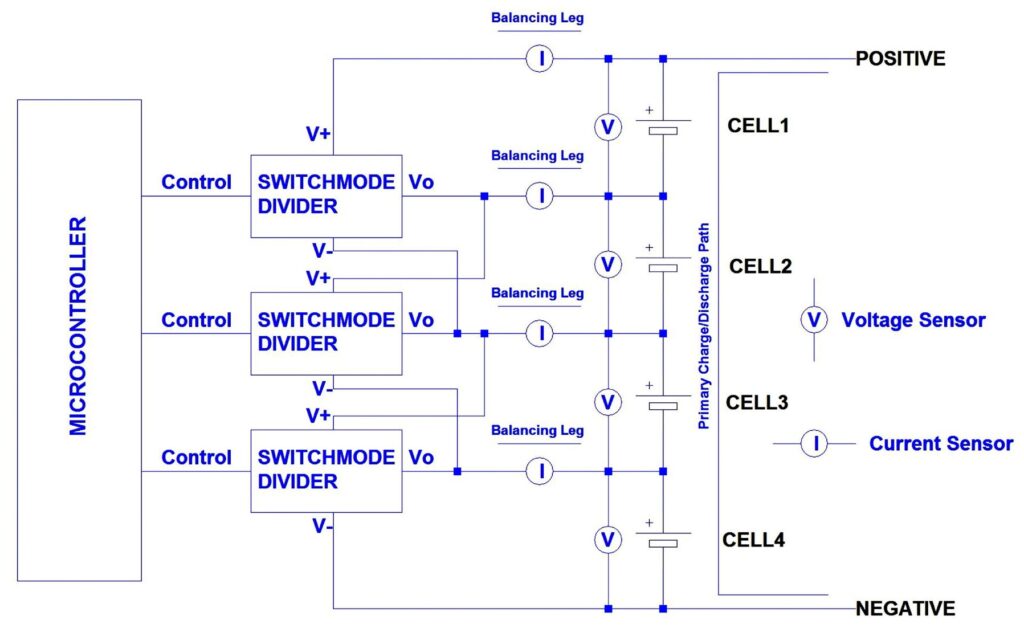
True Balancing uses switch mode dividers (SMDs) to move energy from the primary charge path to any cell in the stack (when balancing during charge) or to move energy from cell to cell (when balancing during discharge).
The output voltage (Vo) of each SMD is connected to a node between two adjacent cells. The high rail of each SMD (V+) is connected to the positive terminal of the cell on the high side of the node. The low rail of each SMD (V-) is connected to the negative terminal of the cell on the low side of the node.
Modulating the control signal to the SMD allows Vo to be set to any voltage between V+ and V-. This allows energy to be diverted off of the primary charge path and moved to any cell. Energy can be moved in either direction – up or down the stack.
Voltage sensors are connected in parallel to each cell in the stack. The microcontroller (µC) samples data from the voltage sensors to determine the relative SOCs of the cells. This identifies cells at lower SOC that need more energy to bring them into balance with the higher SOC cells.
Lithium-ion cells are very low impedance, as are SMDs. So this circuit architecture consists of a series of interconnected low-impedance, high-gain control loops. This is an unstable architecture with risk of runaway current conditions.
To eliminate this risk, current sensors are located on each balancing leg. The µC monitors the current sensors whenever True Balancing is active. If current on any balancing leg approaches a threshold level, the control signal to the associated SMD is adjusted to prevent the balancing current from exceeding the threshold. The threshold levels can be set to have any desired safety margin, which creates a safe, stable and effective system.
Putting current sensors on the balancing legs yields two additional advantages. (1) Locating the sensors off of the primary charge path allows the use of current sensors that are smaller and thus lower cost. (2) Data from the voltage and current sensors allows us to calculate cell impedance (V/I). Sampling the sensors at a regular frequency allows us to calculate dynamic impedance (dV/dI – the first derivative of impedance). Having values of dynamic impedance in real-time on a cell-by-cell basis provides critical information that allows unprecedented and very fine control over the state of the entire pack.
True Balancing can measure AC or DC impedance at small controlled currents during any mode of operation of the battery (charging, powering the load, or idle). This allows accurate characterization of individual cell impedances. The ability to measure and compare cell impedances during any mode of operation provides granular data about conditions of individual cells.
-


TRUE BALANCING LOGIC
This flowchart shows typical logic for executing True Balancing during a charge cycle.
Click on the “Next” button to start a set-by-step walkthrough of the logic.Next
-


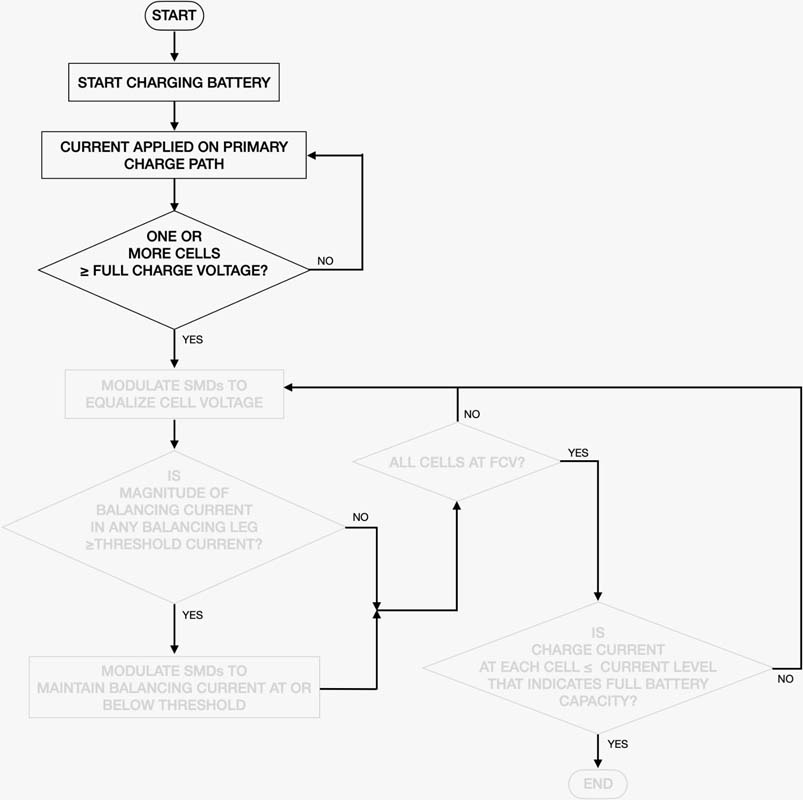
START CHARGING
At the start of the cycle, charge current flows down the primary charge path.
The voltage sensors across each cell are sampled regularly to see if any cell has reached full charge voltage.
As long as all cells are below full charge voltage, charge current continues to flow down the primary charge path.Next
Previous
-


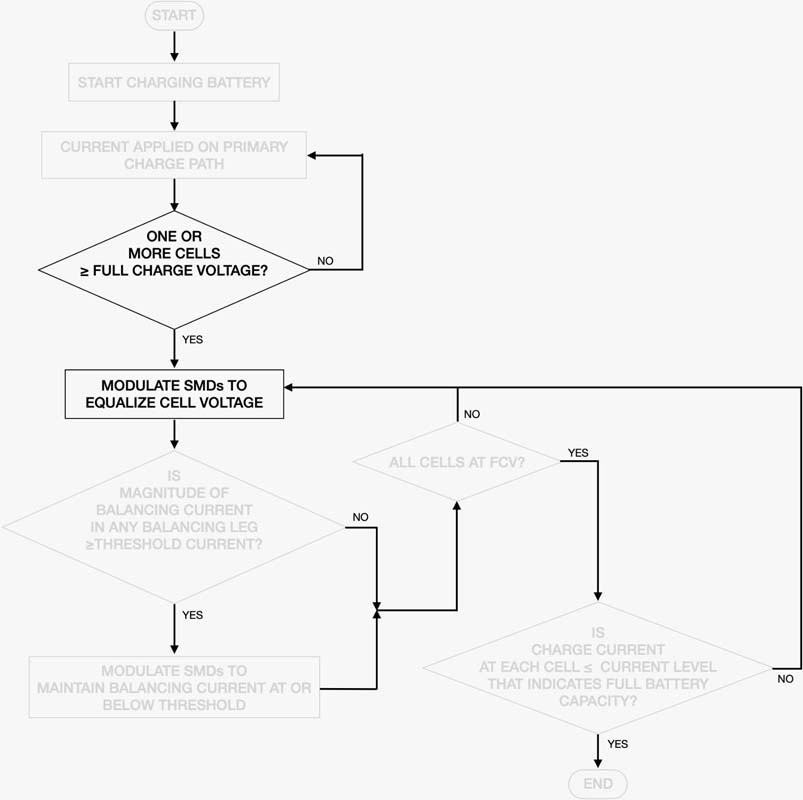
TURN ON TRUE BALANCING
When one or more cells reach full charge voltage, True Balancing starts operating.
The control signals to the switch mode dividers are modulated to divert energy off of the primary charge path and bring energy to cells that are still below full charge voltage.Next
Previous
-


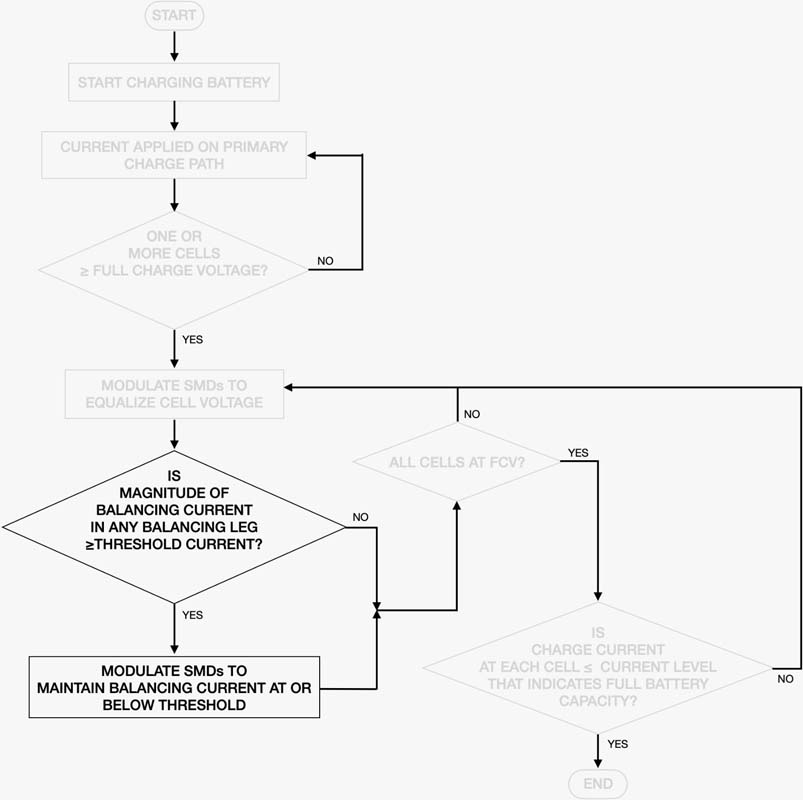
MONITOR THE CURRENT
SENSORSWhile True Balancing is running, the current sensors on the balancing legs are sampled regularly to make sure that balancing current doesn’t exceed the safety threshold.
If current on any balancing leg reaches the threshold, the control signals to the relevant SMDs are adjusted to bring balancing current back below the threshold.Next
Previous
-


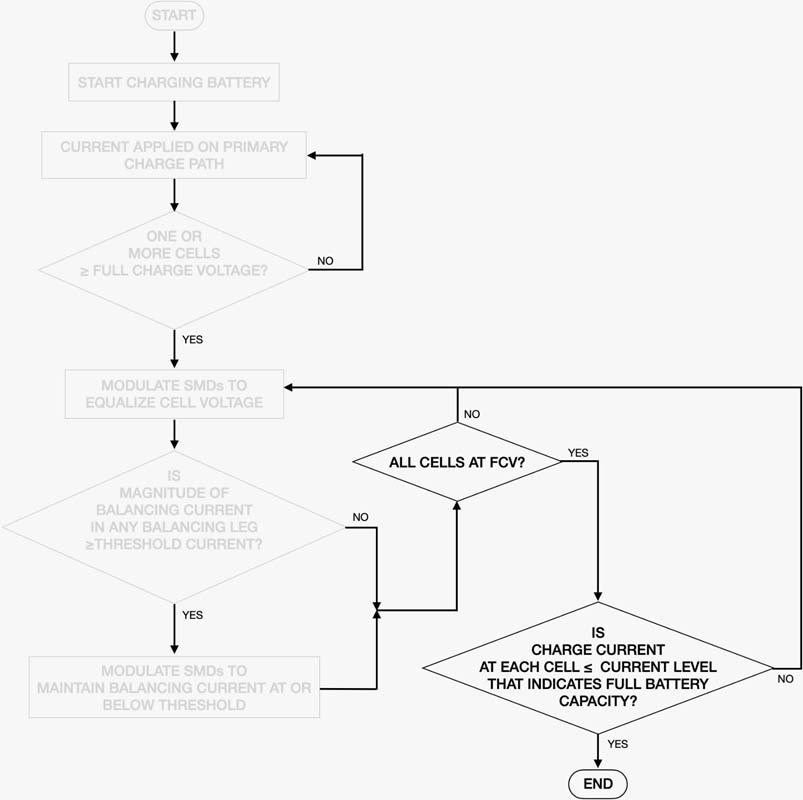
CONSTANT VOLTAGE PHASE
When all cells have reached full charge voltage, the control signals to the SMDs are modulated to maintain all cells at FCV. However True Balancing isn’t finished yet. When all cells first reach FCV, charging isn’t complete. The battery can still hold more energy.
Charging is completed using a constant voltage (CV) profile on a cell-by-cell basis.
During the CV phase of charging, current sensors on the balancing legs are monitored regularly. When charging current to any given cell drops below a threshold (the cut-off current, or COC), that indicates that the cell is fully charged.
Each cell will reach this threshold at a different time. When a cell reaches full charge, True Balancing diverts energy around that cell and continues charging cells that have not yet reached full charge. True Balancing continues to operate this way until every cell in the pack has reached true full charge.Next
Previous
-



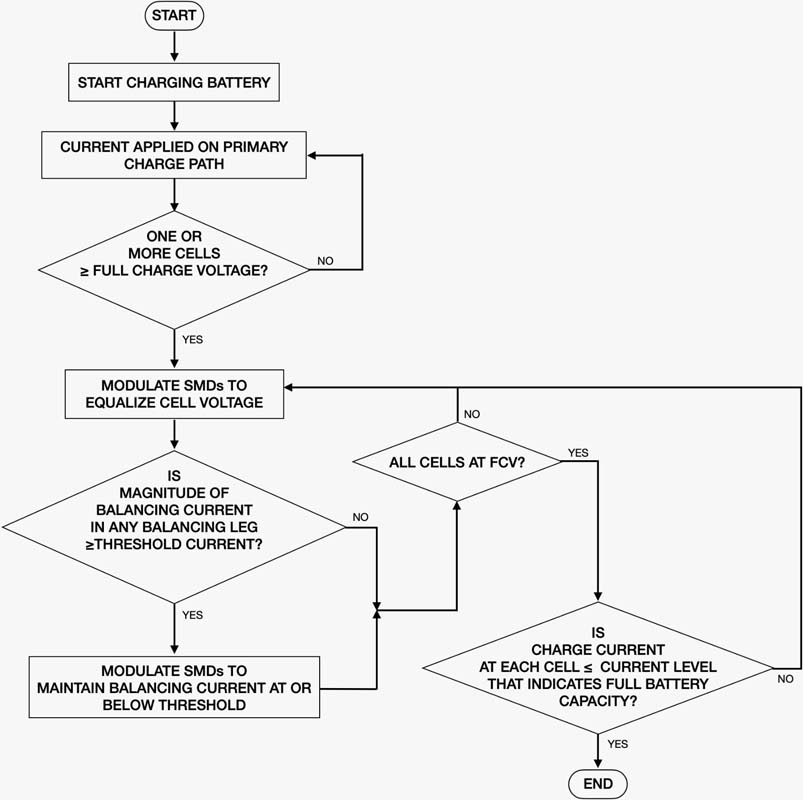
CONCLUSION
We know of no other commercially viable technology that is able to implement a CV charging phase on each individual cell in the series stack. This is one of the features that makes True Balancing unique.
Every cell in the battery, and thus the entire battery, is brought up to true full charge at the end of every charging cycle.
True Balancing can do this with 100% reliability, regardless of the conditions of the individual cells in the battery. The cells can have widely varying capacities, widely varying SOCs, widely varying impedances and widely varying temperatures — and True Balancing will bring every cell in the battery up to true full charge in one fast, efficient charge cycle.
The Articles & Papers page contains documents that present more details about how True Balancing works and how it optimizes battery performance.Previous

